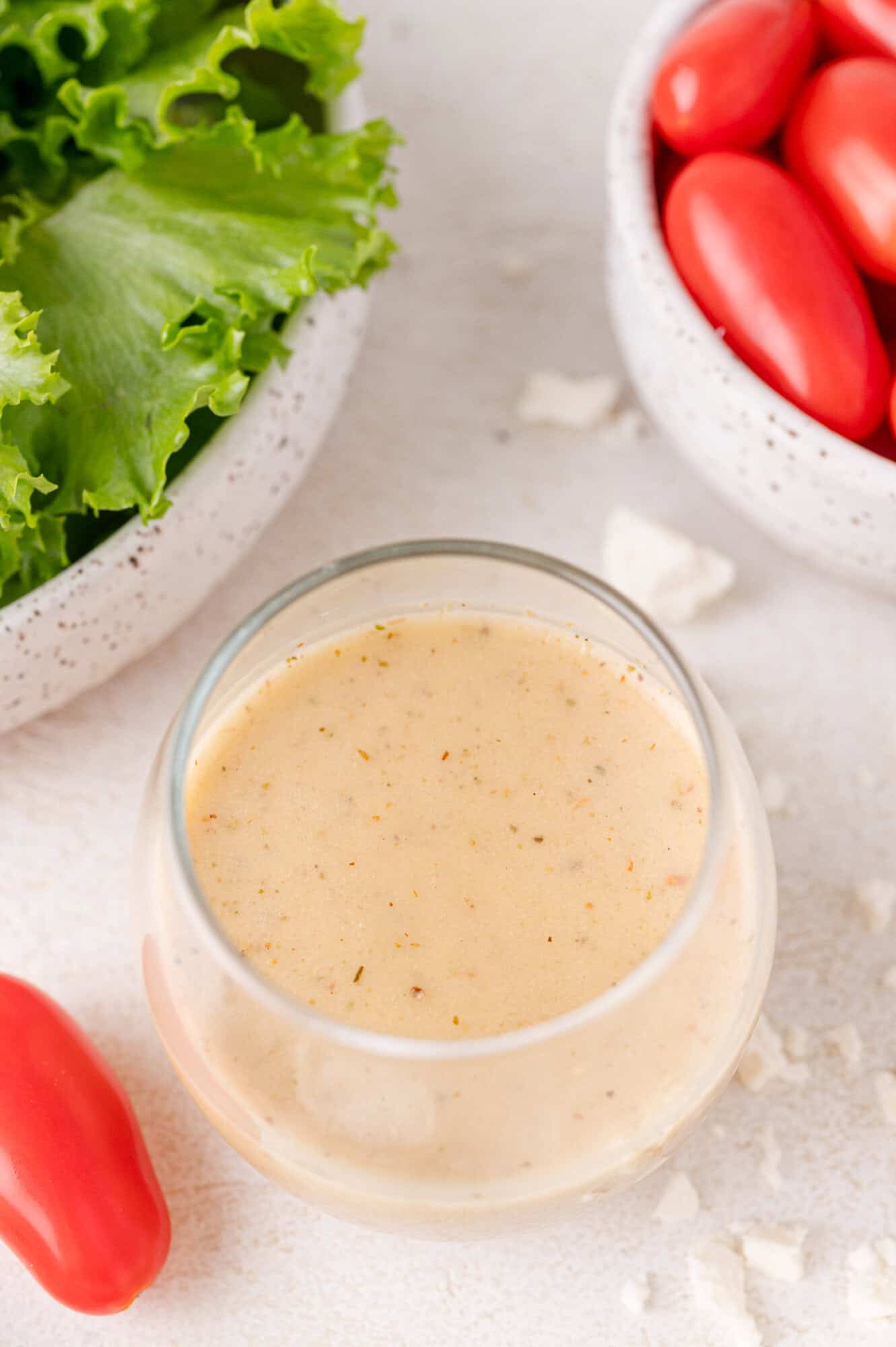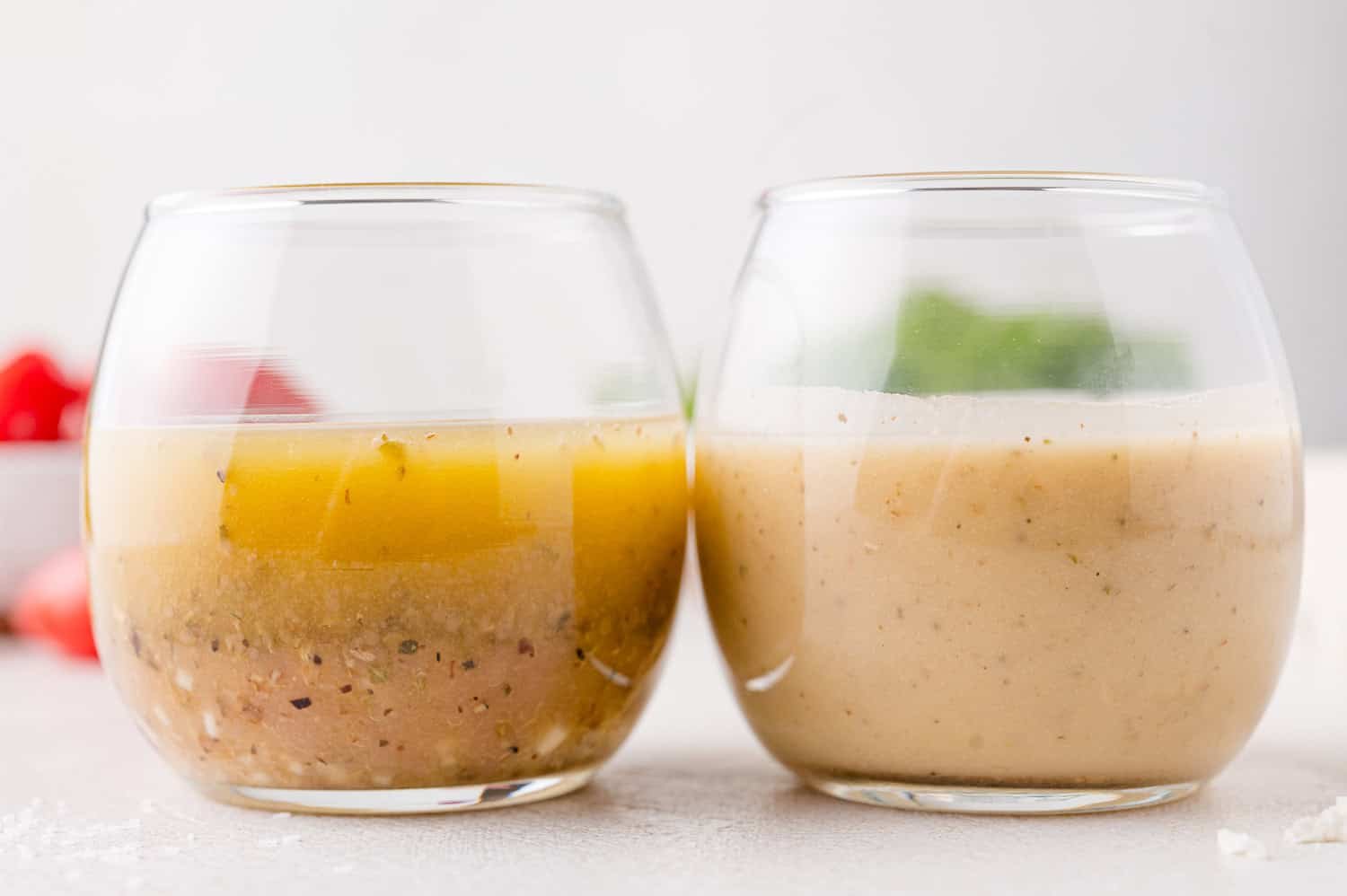Greek Salad Dressing Recipe
Recipe Overview
Why you’ll love it: This Greek salad dressing isn’t just for Greek salad! Use it to add a pop of flavor to any veggies, greens, or salad. You can make it creamy or more like a vinaigrette—it’s up to you!
How long it takes: 5 minutes
Equipment you’ll need: bowl or jar
Servings: 8

Pin this now to find it later
What is a Greek salad without that classic red wine vinaigrette dressing? It’s pretty much essential to the experience if you ask me! You can’t exactly serve a Greek salad with blue cheese dressing or poppy seed dressing. This easy recipe is the platonic ideal when it comes to Greek salad dressing, with a good olive oil, red wine vinegar, garlic, and oregano for that unmistakeable Greek flavor.
Easy Homemade Greek Dressing
Everyday ingredients. You probably have everything you need to make this recipe in your pantry right now which makes it super convenient to make your own. Using your own ingredients is one of the best things about making your own dressing! You can choose quality olive oil and vinegars which are more flavorful and better for you than the commercial brands which use cheap oils, water, and lots of sugar and salt to make them taste better.
Creamy option. Greek salad dressing is usually more like a vinaigrette in consistency but if you emulsify it with a blender, it will take on a more creamy texture, which is super delicious! I like that it seems creamy without adding mayonnaise or yogurt.
A tasty multitasker. In addition to the obvious Greek salad, you can use this dressing as a marinade, toss it with vegetables before roasting, whip up a quick bean salad for lunch, and so much more. I share lots of ideas later in this post.


Ingredient Notes
- Extra virgin olive oil: This is a great opportunity to use a good, high-quality olive oil. Choose extra virgin olive oil which has a greenish hue, with a fruity peppery flavor.
- Red wine vinegar: While the type of vinegar is interchangeable in a lot of dressing recipes, red wine vinegar really is a must for Greek salad dressing.
- Garlic: The vinegar will help tame the bite of raw garlic, mellowing its flavor. That said, if you want it mellower still, just swap a half teaspoon of garlic powder for the fresh garlic.
- Dried oregano: Oregano is another must for Greek dressing!
- Dijon mustard: Mustard isn’t traditional but I like the hidden oomph it gives this dressing; in addition, it helps to emulsify the oil and vinegar.
- Salt and pepper: I always use coarse kosher salt and freshly ground black pepper for cooking. If you use fine salt and pepper, be sure to reduce the amount.

How to Make Greek Salad Dressing
Combine. Add all the ingredients to a small bowl or jar with a tight-fitting lid.
Emulsify. Using a small whisk, vigorously whisk together the ingredients, if you’re using a bowl. If you’re using a jar, put the lid on and shake the dressing until the oil and vinegar emulsify (the oil and vinegar are completely blended together. For a creamier dressing, use a mini blender or stick blender. Compare the two results in the photos.


Use or store. Toss the dressing with your salad or refrigerate it until you need it.


Variations
- Add lemon. Some Greek salad dressing recipes have lemon juice added to them. I usually don’t include it (depending on how I’m using the dressing) but if you’d like to try it, substitute 1 tablespoon freshly squeezed lemon juice for 1 tablespoon of the vinegar.
- Balance the tanginess. If you prefer your dressing on the sweeter side, you can add ½ teaspoon of granulated sugar or honey, or as much as you need.
- Try fresh herbs. Have oregano growing in your garden? Or maybe some in your fridge left from another recipe? You can mince it finely and use that instead of dried. Use 1 ½ teaspoons because fresh herbs aren’t as potent as dry herbs.

How You Can Use Greek Salad Dressing
- Marinade. Use the dressing as a marinade for chicken or fish. Combine the dressing and meat in a shallow dish; cover and refrigerate for an hour before cooking. I also love this yogurt-based Greek chicken marinade. It’s one of my favorite marinades because the enzymes in the yogurt help tenderize the chicken.
- Vegetables. Toss vegetables like bell peppers, zucchini, eggplant, and onions with the dressing before roasting in the oven for an easy side dish. Alternatively, roast the vegetables first and then toss them with the dressing right before serving. Try it on air fryer eggplant, grilled zucchini, or roasted broccoli.
- Bean salad. Mix together drained and rinsed chickpeas or cannellini beans, chopped vegetables, cubed feta, and Greek salad dressing for a quick bean salad, like this chopped Greek salad.
- Pasta salad. Use the dressing for a Greek-inspired pasta salad by mixing it with cooked rotini, olives, cherry tomatoes, feta cheese, and cucumbers.
- Dip. Use the creamy version of the dressing as a dip for raw veggies or a roasted vegetable wrap.
Refrigerate Greek salad dressing in a jar or airtight container for up to a week. Whisk or shake it before serving; if it solidifies in the fridge, let it come to room temperature before you use it.
Combine all ingredients in small bowl or jar with a tight-fitting lid. Whisk or shake until completely combined (emulsified). You can also blend the dressing if desired – see notes. Serve immediately or refrigerate until ready to use. Whisk or shake again before serving.
¼ cup extra virgin olive oil, 3 tablespoons red wine vinegar, 1 garlic clove, minced, ½ teaspoon dried oregano, ½ teaspoon Dijon mustard, ¼ teaspoon kosher salt, ⅛ teaspoon coarse ground black pepper, more to taste
- Garlic: For a less assertive garlic flavor, use ½ teaspoon of garlic powder instead of fresh garlic.
- Creamy Greek salad dressing: Combine ingredients in a blender container. Briefly blend until smooth and creamy. We use a hand-held stick blender and it works well.
- Storage: Refrigerate dressing in a jar or airtight container for up to a week. Whisk or shake it before serving; if it solidifies in the fridge, let it come to room temperature before you use it (10 to 15 minutes).
Serving: 1tablespoon, Calories: 62kcal, Carbohydrates: 0.3g, Protein: 0.1g, Fat: 7g, Saturated Fat: 1g, Polyunsaturated Fat: 1g, Monounsaturated Fat: 5g, Sodium: 77mg, Potassium: 6mg, Fiber: 0.1g, Sugar: 0.01g, Vitamin A: 3IU, Vitamin C: 0.1mg, Calcium: 3mg, Iron: 0.1mg
Nutrition information is automatically calculated, so should only be used as an approximation.

